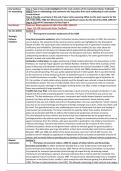Summary
Summary Cornell notes on What explains the fall of the USSR, 1985-91?
- Institution
- PEARSON (PEARSON)
Cornell notes for the Edexcel history 1E unit - chapter 5 - interpretations What explains the fall of the USSR, 1985-91? seven sections of notes from an A* Student used in A-Levels
[Show more]



